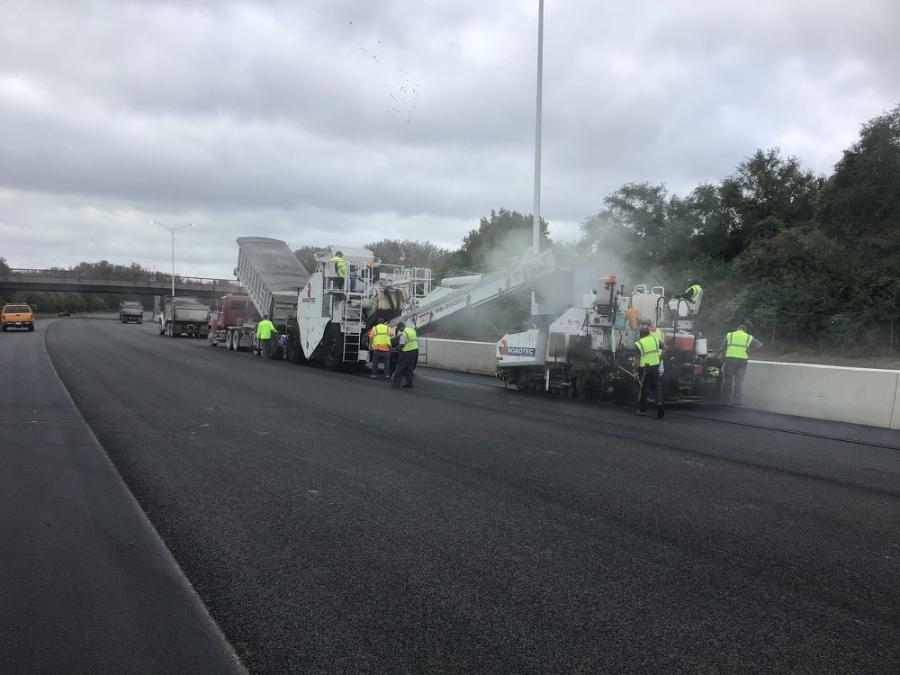The full closure saves time, as well as money, allowing the project to be completed in just 10 months, rather than four years, saving taxpayers $14 million.
(IDOT photo)
Crews in Illinois have put the finishing touches on a major rehabilitation effort that required closing an interstate for one construction season. The $67.3 million I-255 project called for rehabilitating and resurfacing approximately 7 mi. of I-255 from Collinsville Road to Illinois 15 in two sections separated by Interstate 64. At issue was a badly deteriorated section of interstate in the St. Louis Metro East area.
"This section of I-255 was originally built in the 1980s, and has not seen any major improvements since it was originally constructed," said Joel Cumby, construction engineer, Illinois Department of Transportation (IDOT) District 8. "For years, IDOT and the Missouri Department of Transportation [MoDOT] have been working together to develop and coordinate improvements to the transportation infrastructure in this region."
The contract was awarded in December 2019, with pre-closure work beginning in early January 2020.
"On June 13, we switched over from the north section to the south section, and due to the contractor's aggressive schedule we opened the south section on October 31. The total closure only lasted nine months," he said.
The project was due to complete in November, but was opened a full month ahead of schedule.
Cumby said constructing the project under full closures was safer for both motorists and workers by providing a full separation. The full closure saves time, as well as money, allowing the project to be completed in just 10 months, rather than four years with traditional staging methods. By utilizing full closures on the project, taxpayers save $14 million.
"To construct this project under traditional staging methods, we would have had to upgrade the shoulders, in order to shift traffic onto them, and there would have been the need for extremely long runs of temporary concrete barrier to provide positive protection for the workers. There also would have been numerous reconfigurations of the traffic control and traffic patterns throughout the project, in addition to the various shadowed pavement markings resulting from the various reconfigurations, both of which would have been confusing to the motorists."
Under traditional staging, the existing pavement would not have been able to withstand the stresses of all the traffic being confined to just one lane, and would have resulted in emergency closures, with no warning and no defined detours.
The project includes significant bridge repairs, safety improvements and drainage upgrades. The work was essentially the same in each section. The north section had 10 bridges to repair, including one complete deck replacement, while the south section had eight bridges to repair.
Types of major equipment used on the project included excavators, backhoes, trenchers, wheel saws, air compressors, concrete mixer trucks, asphalt distributor trucks, liquid asphalt sprayers, material transfer devices, asphalt pavers and asphalt rollers. Road wideners also were used, as well as skid steers, compact track loaders, dump trucks, concrete pump trucks, rough terrain cranes, bridge deck finishing machines, manlifts, vactor trucks, flatbed trucks and semi-trucks with flatbed trailers.
Construction called for 133,000 tons of hot mix asphalt; 7,500 cu. yds. of concrete; 26,000 lbs. of structural steel; and 390,000 lbs. of reinforcing steel. Other materials included 20,000 ft. of median barrier; 32,000 ft. of guardrail; 1,700 tons of aggregate shoulders; and 11,000 tons of riprap.
The joint venture of The Kilian Corporation and Keeley & Sons Inc. served as the prime contractor. A diverse team of local subcontractors and trucking firms was secured to accomplish the large volume of work.
"The prime contractors also hired a diverse workforce, and have been working very closely with the local trade organizations to hire a workforce that is representative of the area," said Cumby. "Approximately $13 million worth of work was accomplished by disadvantaged business enterprises."
Cumby noted that the undertaking was identified through a multi-year process of project identification, based upon the condition of the bridges and pavement. The engineering for the project was started and it progressed through the Rebuild Illinois program.
"The Rebuild Illinois capital program is a $45 billion project to restore the state's aging transportation system," said Cumby. "The funding for the program comes from the state's gambling expansion, increased fees at the driver's services facilities, doubling of the gas tax and a higher tax on tobacco.
"Illinois is the sixth largest state, and the transportation hub of the nation, but it hadn't had a comprehensive capital plan since 2009. As a result, Illinois infrastructure was in dire shape, with a $30 million maintenance backlog. The state also was in danger of losing federal funds, due to historically insufficient funding commitments by the state and deteriorating system conditions. Not only is Rebuild Illinois the largest capital project in state history, it is one that will affect all modes of transportation." CEG
Cindy Riley
Birmingham, Ala., native Cindy RIley originally planned on a career in law, but during her sophomore year in college realized journalism was her true calling. A magna cum laude graduate of Samford University, Riley first worked in radio and TV. Named Best News Anchor, Best News Reporter and Best Investigative Reporter by the Associated Press, she interviewed numerous personalities, ranging from Dr. Henry Kissinger and President Bush to Michael Jordan and Captain Kangaroo.
As a print journalist, Riley has covered a variety of topics, including construction, business, health and the arts. In addition to CEG, her work has appeared in special reports for USA Today and the L.A. Times. Other publications have included New South Magazine, Portico, Thicket, Alabama Heritage, B-Metro, Business First and Birmingham Business Journal.
Read more from Cindy Riley here.
Today's top stories
















